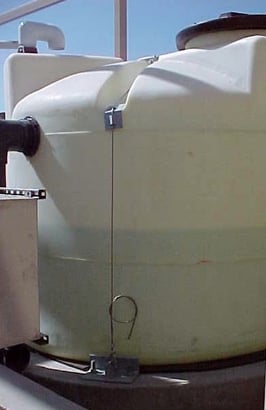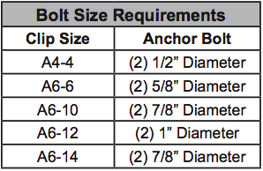Storage Tank Seismic Restraints - We Can Help

Note: Poly Processing's seismic clip names have changed from L designation to A designation. The clip thicknesses have changed as well. Please feel free to contact customer support for any clarification you might need.
One natural event that could potentially lead to catastrophic risk, resulting in a complete failure of a chemical storage tank system, is an earthquake. Earthquakes can happen in areas not considered earthquake zones, such as the August, 2011 5.8 magnitude tremor that rocked Virginia.
Considering the risk of an earthquake on a chemical storage tank, a proper restraint system is essential. Let’s explore the steps needed to protect your chemical storage tank in the event of an earthquake.
Evaluate the Earthquake Risk
It’s vital to determine the possibility of a seismic event at the specific location of the polyethylene chemical storage tank. Poly Processing uses the latest International Building Code, per the local jurisdiction to design restraint systems for polyethylene plastic storage tanks. As of this writing the current IBC is 2015. The actual location and seismic activity are evaluated to ensure system safety.
How Do Polyethylene Tanks React in a Seismic Event?
Fiberglass tanks are more rigid and brittle than polyethylene tanks and therefore can’t absorb higher seismic and wind forces. Polyethylene is more ductile, absorbing the forces and stresses during a seismic event. As a result, the risk of damage to the polyethylene chemical storage tank is less than a steel or fiberglass tank.
How a Seismic Tank Restraint System Is Designed
 The size of the polyethylene storage tank, the weight of the fluid, and the type of chemical being stored will determine the restraint system required to prevent damage to the tank during an earthquake. Clip material differs from the polyethylene tank construction. Materials used are typically either 304 or 316 stainless steel or galvanized steel. These clips confine the tank to the surrounding area during an earthquake.
The size of the polyethylene storage tank, the weight of the fluid, and the type of chemical being stored will determine the restraint system required to prevent damage to the tank during an earthquake. Clip material differs from the polyethylene tank construction. Materials used are typically either 304 or 316 stainless steel or galvanized steel. These clips confine the tank to the surrounding area during an earthquake.
Fiberglass tanks, typically with the clips molded into the tank design, work as long as material structure of the fiberglass tank isn’t compromised. Damage to these structural components can be difficult or impossible to detect on fiberglass chemical storage tanks.
Inspection of seismic restraints is simplified with polyethylene tanks since the restraints are separate from the tank and made of steel. It’s important to visually inspect the steel tank clips and any cables and anchor bolts for corrosion to make sure the restraint system will be effective if it’s needed.
Concrete Pad Design
One of the often-asked questions is “how should I design and pour my pad to accommodate the tank and the seismic system?” Poly Processing has a set of standards which can help the engineer, contractor, or the end user engineer the correct pad for the tank. The pad size is dependent on both the tank size and seismic system being purchased. Below are a couple of PPC-created tables which showcase standards for pad design. This table is based on locations with Ss=1.700 and S1=0.750 values or less.
Note: Anchoring requirements can be modified per specific site and tank size as required to meet customer’s needs. Clip names have changed from L designation to A designation. Thickness of the clips have changed as well based on IBC 2015.

 Minimum Edge Distance – The distance from the sidewall of the tank to the edge of the pad.
Minimum Edge Distance – The distance from the sidewall of the tank to the edge of the pad.- All concrete pads need a 28 day compressive strength of 2500 psi. minimum or as directed by American Concrete Institute (ACI) 318-11.
Concrete Pads For IMFO Tanks
Poly Processing Company has developed an Integrally Molded Flanged Outlet (IMFO) that minimizes the hazards associated with traditional vertical tank draining and maintenance. With Poly’s Integrally Molded Flanged Outlet, or IMFO system, the flange is molded at the bottom knuckle radius while the tank is processing, making it a stress-free part of the tank. The flange therefore sits below the bottom of the tank to create this full drain feature. We recommend that the pad be notched where the IMFO will sit so that the pad will not interfere with the fitting assembly. We have put together drawings which show the different pad shapes and how the IMFO area should be notched. They are available at the bottom of the IMFO page.
Poly Processing has been supplying seismic calculations and systems for our tanks for over 30 years. We recommend contacting a storage tank system expert for your individual seismic restraint needs.
- February 16, 2017
- Topics: Installation and Service, Fittings and Accessories
About Poly Processing
Posts By Topic
Tech Talk Podcast Episodes
Subscribe By Email
Recent Posts
- Protect Your Facility and Your Bottom Line with a Chemical Leak Detection System
- PPC Installation, Operation, and Maintenance Manual: Ensure Tank Longevity
- How To Use The Chemical Resistance Guide
- Better and Safer Alternatives to Downpipes
- Crosslinked Polyethylene Vs. Fiberglass Reinforced Plastic Tanks
Tank Configurator

Find the recommended tank and system components for your chemical storage challenge.
Configure a Tank Package



